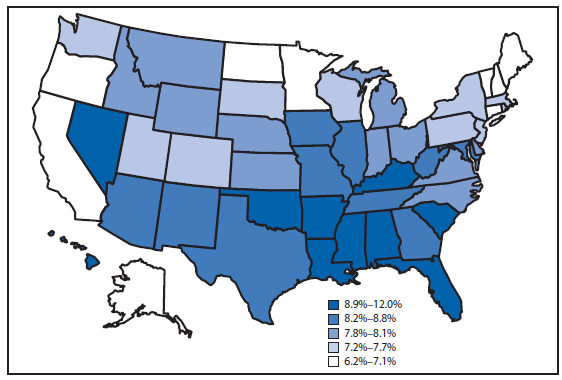QuickStats: Percentage of Infants Born Late Preterm,* by Mother's State of Residence — National Vital Statistics System, United States, 2012

* Defined as a gestational age (interval between the date of the mother's last normal menses and the date of birth) of 34–36 completed weeks. Late preterm births accounted for 70% of all preterm births in 2012 and are considered to be at less risk than births at <34 weeks (early preterm) but at greater risk for birth complications and subsequent health or medical problems than full-term births.
In 2012, 8.1% of births in the United States were late preterm births. The percentage of births that were late preterm varied by state and ranged from 6.2% in Vermont to 12.0% in Mississippi.
Sources: Martin JA, Hamilton BE, Osterman, MJK, Curtin SC, Mathews T. Births: final data for 2012. Natl Vital Stat Rep 2013;62(9). Available at http://www.cdc.gov/nchs/data/nvsr/nvsr62/nvsr62_09.pdf.
US Department of Health and Human Services. Health indicators warehouse. Hyattsville, MD: US Department of Health and Human Services; 2013. Available at http://www.healthindicators.gov.
Reported by: Kate M. Brett, PhD, kbrett@cdc.gov, 301-458-4113; Li-Hui Chen, PhD.
Alternate Text: The figure above shows the percentage of infants born late preterm, by mother's state of residence during 2012. In 2012, 8.1% of births in the United States were late preterm births. The percentage of births that were late preterm varied by state and ranged from 6.2% in Vermont to 12.0% in Mississippi.
Use of trade names and commercial sources is for identification only and does not imply endorsement by the U.S. Department of
Health and Human Services.
References to non-CDC sites on the Internet are
provided as a service to MMWR readers and do not constitute or imply
endorsement of these organizations or their programs by CDC or the U.S.
Department of Health and Human Services. CDC is not responsible for the content
of pages found at these sites. URL addresses listed in MMWR were current as of
the date of publication.
All MMWR HTML versions of articles are electronic conversions from typeset documents.
This conversion might result in character translation or format errors in the HTML version.
Users are referred to the electronic PDF version (http://www.cdc.gov/mmwr)
and/or the original MMWR paper copy for printable versions of official text, figures, and tables.
An original paper copy of this issue can be obtained from the Superintendent of Documents, U.S.
Government Printing Office (GPO), Washington, DC 20402-9371;
telephone: (202) 512-1800. Contact GPO for current prices.
**Questions or messages regarding errors in formatting should be addressed to
mmwrq@cdc.gov.


